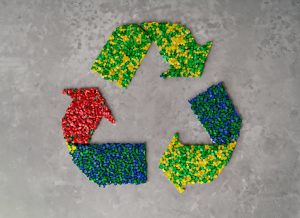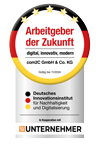Fire protection certificates for print media are an important aspect in large format printing: on the one hand to ensure the safety of people and buildings, on the other hand to comply with regulations.
In public buildings and at trade fairs in particular, the use of flame-retardant print media is usually required. In addition to the well-known B1 certificate, the European standard EN 13501-1:2019 is important.
We explain the differences and similarities between the various national and international fire protection classes.
The B1 certificate is a certificate for flame-retardant materials and was often used in Germany as a benchmark for the fire safety of materials. A material that has been awarded a B1 certificate corresponds to a flame retardant class. Certified building materials of class B1 must not continue to burn on their own after the heat source that ignited them has been eliminated. This is tested and certified in recognized test laboratories.
Since 2002 there have also been the European standards EN 13501-1 and EN 13501-2, which regulate the requirements for fire safety of materials in Europe.
The new European fire safety certificates for print media have been developed to unify and standardize the fire safety of materials in Europe. The EN 13501-1 standard regulates the requirements for the fire safety of materials and defines different classes of fire protection requirements, from non-combustible (class A1) to easily flammable (class F). Class B-s1,d0 is generally considered to be the benchmark for fire safety of materials in public buildings in Europe.
The conditions for issuing fire protection certificates vary depending on the country and area of application. In Germany, materials used in public buildings or at trade fairs usually had to have a B1 certificate in accordance with DIN 4102. However, the European standard EN 13501-1 is gaining in importance.
The two standards cannot be compared 1:1 with each other, as the European system is the first to define side effects of fire, such as smoke development and flaming droplets or falling off. The details can be found in our table – see below.
The main differences between the certificates are the fire safety requirements and the test methods. For example, a material that has received a B1 certificate in Germany may not meet fire safety requirements in other countries. It is therefore important to take into account the respective national regulations and standards.
Legend for the table:
A: no contribution to the fire (A1, A2)
B: very limited contribution to the fire
C: limited contribution to the fire
D: acceptable contribution to fire
E: acceptable fire performance
Q: no performance detected
fire by-products
like smoke development (s = smoke)
or burning droplets/particles (d = droplets):
s1: low smoke development
s2: average smoke development
s3: high smoke development or smoke development not tested
d0: no flaming droplets/particles within 600 seconds
d1: no flaming droplets/particles with an afterflame time longer than 10 seconds within 600 seconds
d2: no performance determined
Compared to the B1 standard, class B-s1,d0 is usually stricter and places higher demands on the fire safety of materials. A material that has been awarded a B1 certificate also meets certain fire safety requirements, but these requirements are usually not as high as for class B-s1,d0. Nevertheless, in countries like Germany, the B1 certificate is still considered a benchmark for the fire safety of materials in public buildings.
Overall, the new European fire safety certificates for print media offer a standardized method for assessing the fire safety of materials. Class B-s1,d0 is considered the benchmark for fire safety of materials in public buildings in Europe and offers a higher level of fire safety than the B1 standard.
com2C print media with European flame retardant certificate
The following digital print media from com2C already have a fire protection certificate in accordance with European standard EN 13501-1:2019:
GreenFilm 100 PP LUVESS MW air rem adh FR
GreenFilm 100 PP LUVESS MW ultra tack air adh FR








